Alaska Roll
Sushi...With Salmon

What Is Alaska Roll?
The Alaska roll is a variation of sushi that typically features smoked or fresh salmon as its main ingredient, often accompanied by avocado, cucumber, and sometimes cream cheese.
Ingredients For Alaska Roll


Produce
2 Mini Cucumbers
1 Avocado

Grocery
2 Cups Sushi Rice
2 Tbsp Sugar
1/2 Cup Rice Vinegar
Nori Sheets

Meat
1 Pound Sushi Grade Raw Salmon
How To Make Alaska Roll
Step 1
Wash & Cook Rice
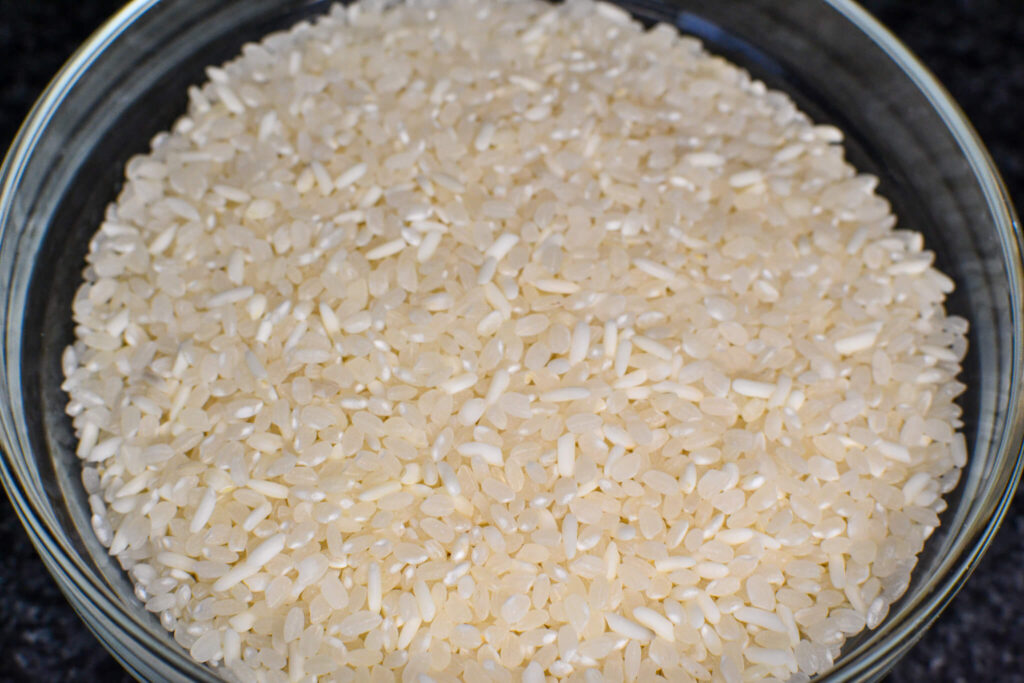
The base of sushi, including the Alaska Roll, is its rice. Good sushi rice is sticky, looks shiny, and keeps its shape, but you can still tell each grain apart. To get this, you start with picking the right rice. Short-grain sushi rice is the best because it’s sticky and soaks up the mix of rice vinegar, sugar, and salt well, which makes the rice taste like sushi rice should.
For this recipe, I chose the premium Rice Select Sushi Rice.

The first step is to clean the rice. Put the rice in a big bowl, fill it with cold water, and stir it lightly with your hands. The water will become cloudy from the starch. Pour out this water and do it again several times until the water looks mostly clear. This is important to take away extra starch, which can make the rice too sticky and dense if not washed off.
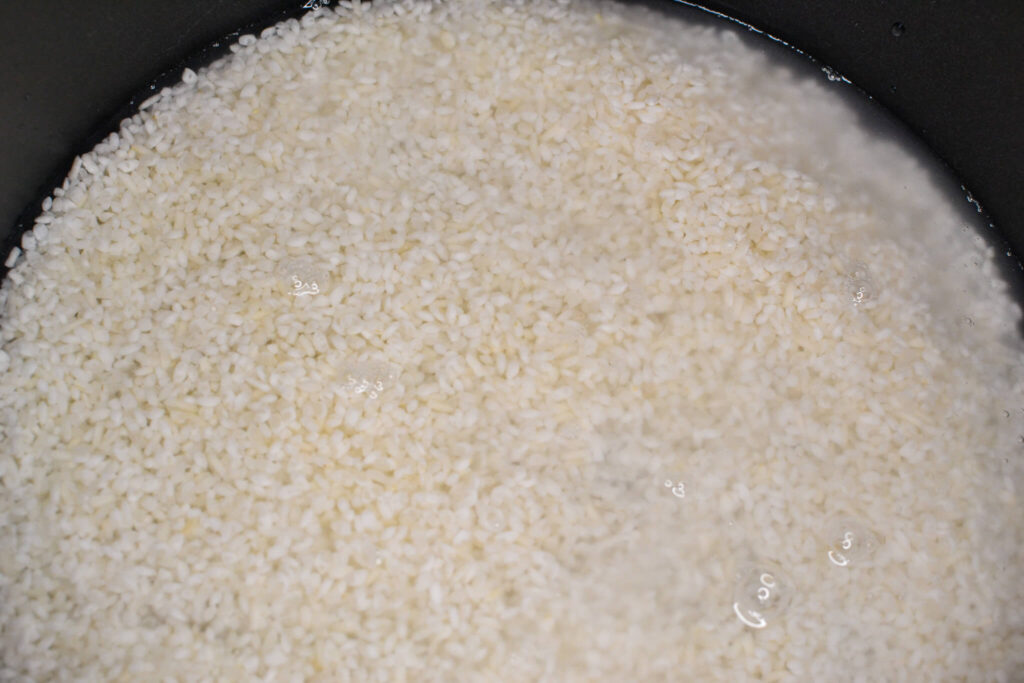
After washing the rice well, it’s time to cook it. If you have a rice cooker, use the instructions for sushi rice. If you’re cooking on the stove, mix the washed rice with water using a 1 to 1.2 ratio (rice to water). Boil it, then simmer on low heat with the lid on for 15 minutes. Let the rice sit with the lid on for 10 minutes to steam after cooking.

While the rice cooks, prepare the sushi vinegar by whisking together rice vinegar, sugar, and a pinch of salt until the sugar and salt dissolve.

Once the rice is done and slightly cooled, transfer it to a large bowl (preferably wood or plastic to avoid reacting with the vinegar).
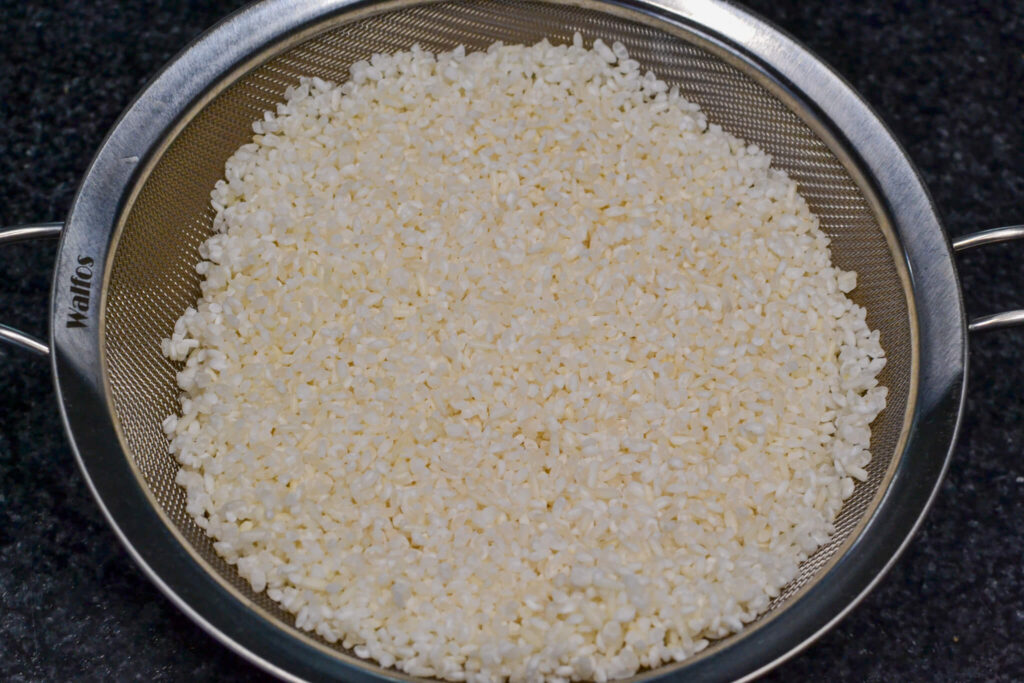
After rinsing the sushi rice until the water is almost clear, the next important step is to drain it. This is important to get rid of any extra water, making sure the rice cooks evenly and ends up with the perfect texture. To drain the rice, put it in a fine strainer or colander.
Let it sit and drain for about 15 to 30 minutes. This waiting time is important because it lets the rice dry a bit, which helps it soak up the right amount of water when it’s cooked. Draining helps with the rice’s final texture and how well it sticks together for sushi, making it a key step in making sushi rice.
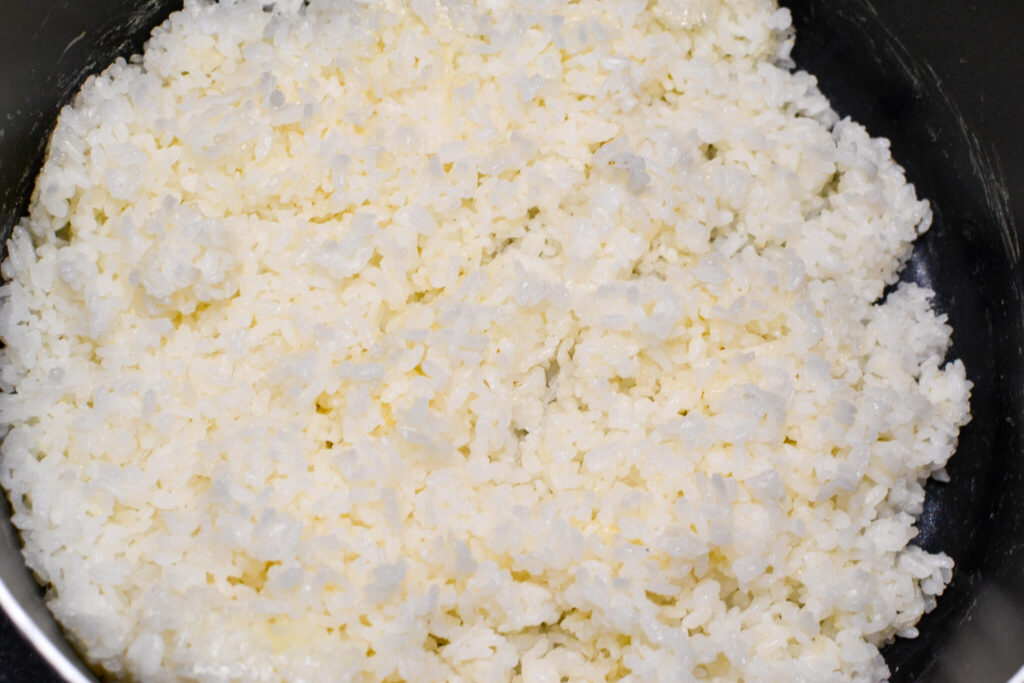
Mix in the vinegar mixture carefully with a spatula, using slicing motions to keep from smashing the rice grains. This not only flavors the rice but also makes it look shiny. Let the rice cool down to room temperature before you start making your sushi. Spreading it out on a big plate can help cool it faster.
Step 2
Prep Produce

Begin with the cucumber, aiming for thin, even strips that add a nice crunch without being too much for the roll. First, wash the cucumber, trim off the ends, and cut it in half lengthwise. This will show the seeds, which you can then remove with a spoon.

Taking out the cucumber seeds is important to keep the sushi from getting too wet. This way, the cucumber adds a fresh crunch without adding extra water that could affect the roll’s structure and texture.
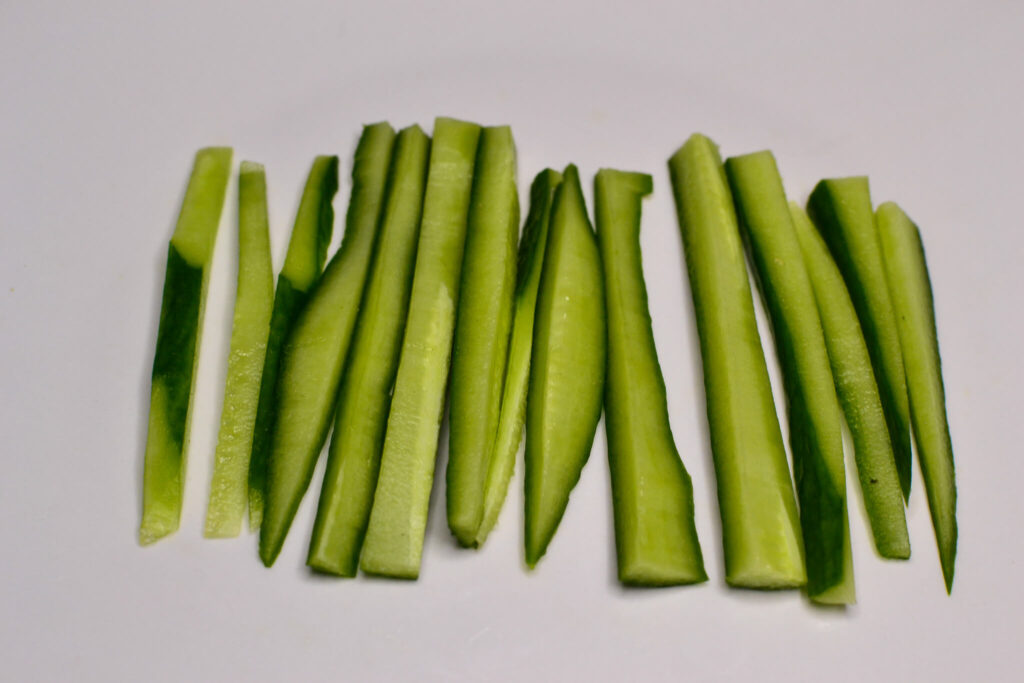
Next, slice the cucumber halves without seeds into thin strips. These thin strips are key for getting the right mix of textures in the roll. They fit in smoothly with the other ingredients, offering a gentle crunch that goes well with the soft rice and tender salmon, without overpowering the flavors.
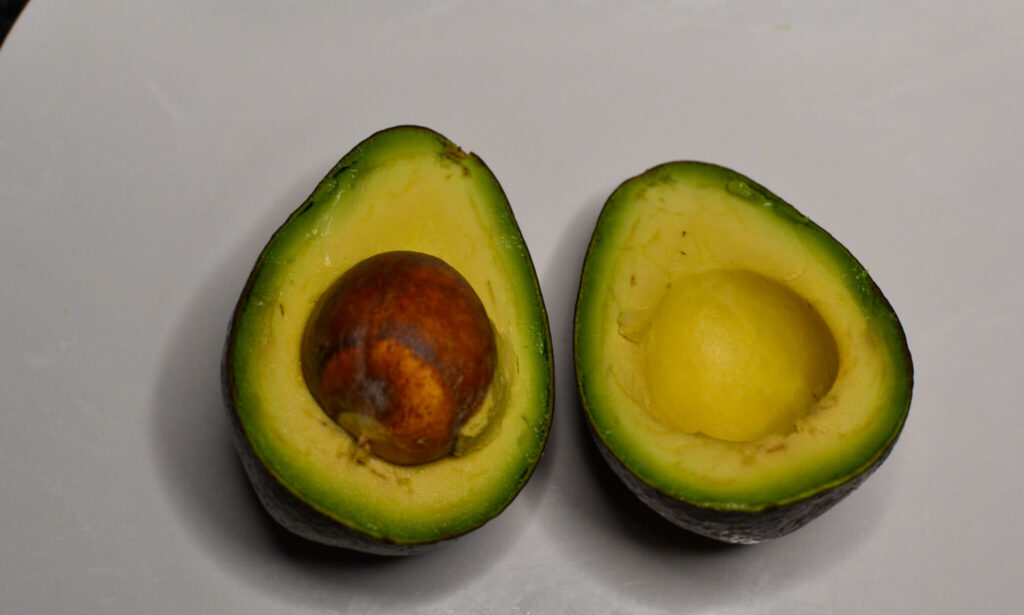
Avocado adds a creamy and rich texture that perfectly complements the cucumber’s crispness and the salmon’s tenderness.
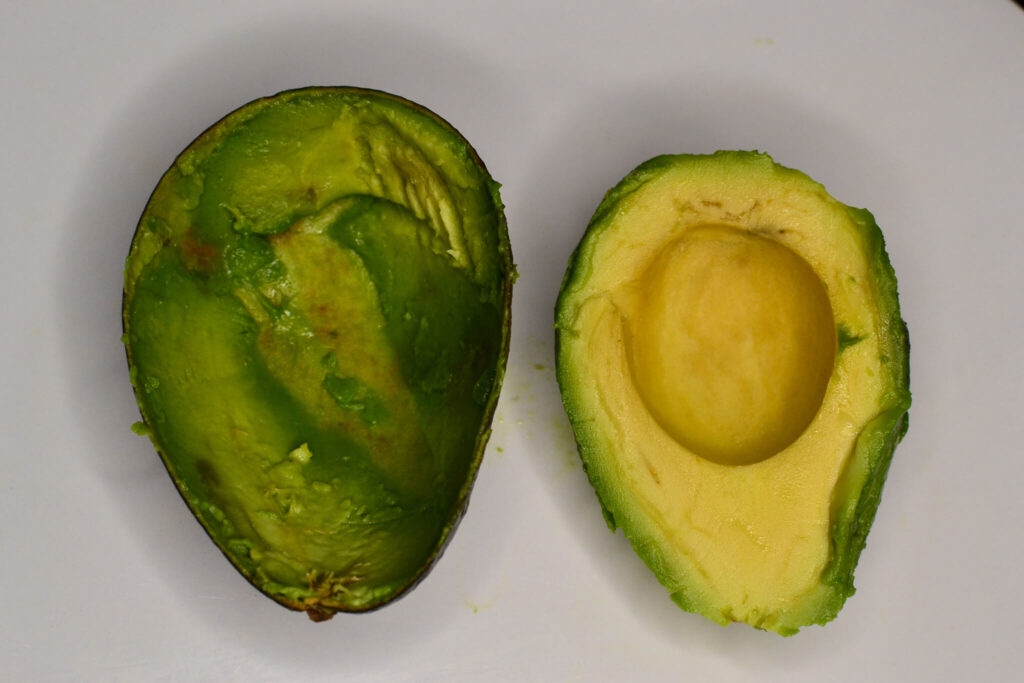
To get perfect avocado slices, choose an avocado that’s ripe but still firm. Cut around the pit and twist the halves apart, then remove the pit. You can carefully peel off the skin or scoop out the avocado flesh.
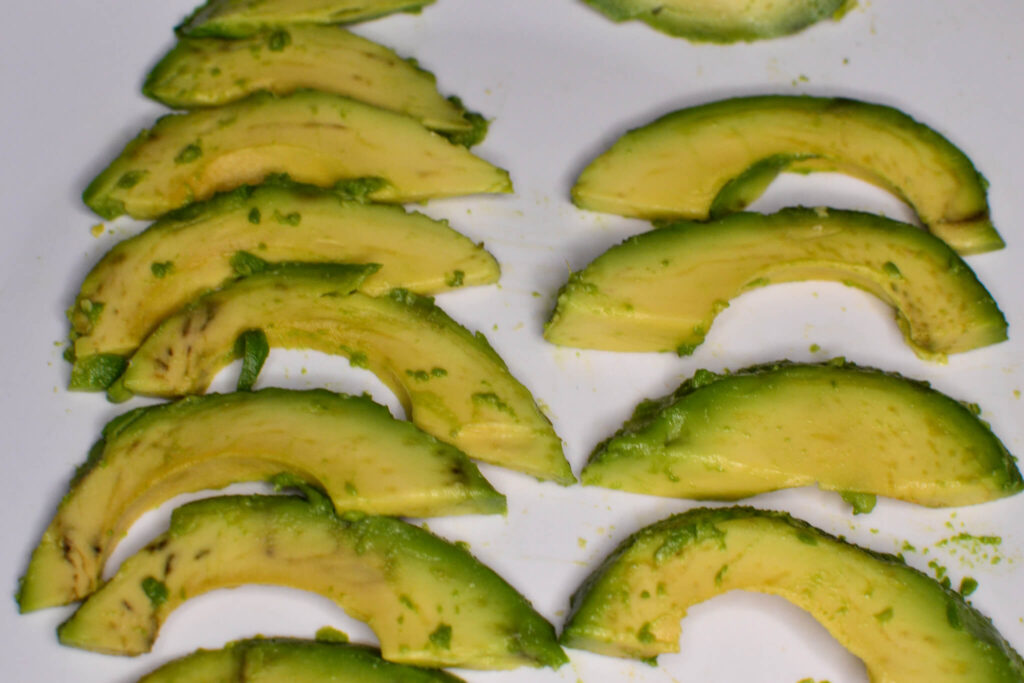
Once you’ve removed the avocado flesh, slice it into thin pieces. This step needs a careful but steady hand to make sure each slice is even and whole, ideal for adding to the sushi roll. Thin slices ensure the avocado spreads out well in the roll, giving a creamy texture with every bite.
Hopefully your avocados aren’t as ugly as mine.
Step 3
Cut Salmon
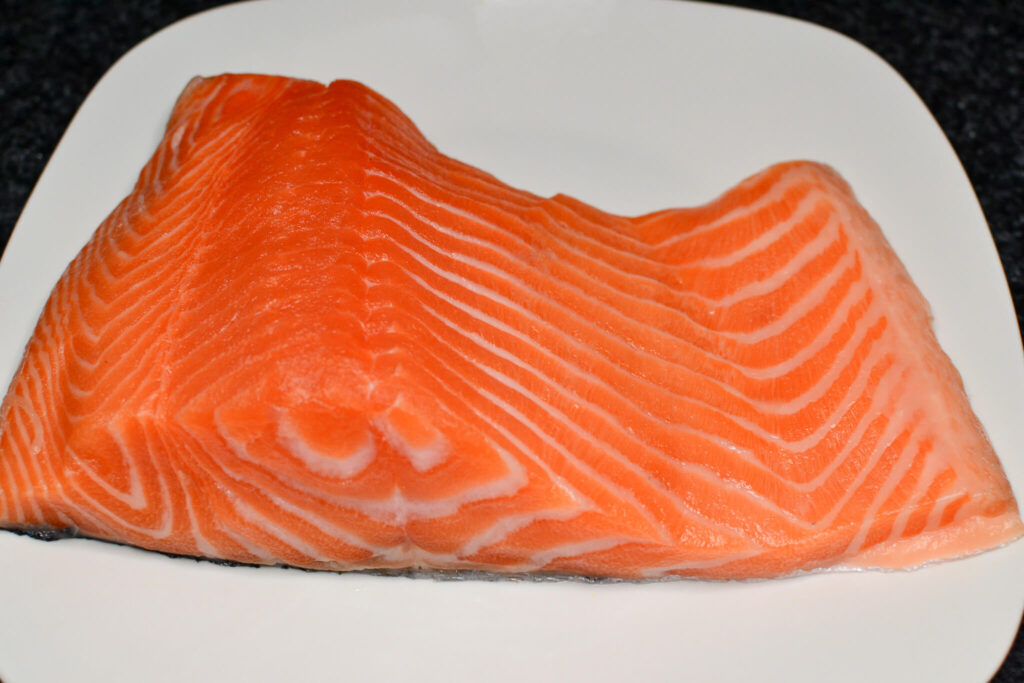
The salmon is the star of the Alaska Roll, and preparing it highlights the skill involved in making sushi. Start by choosing the right salmon, which should be sushi-grade. This means it has been frozen to a temperature that kills any parasites, making it safe to eat and ensuring the dish’s quality.
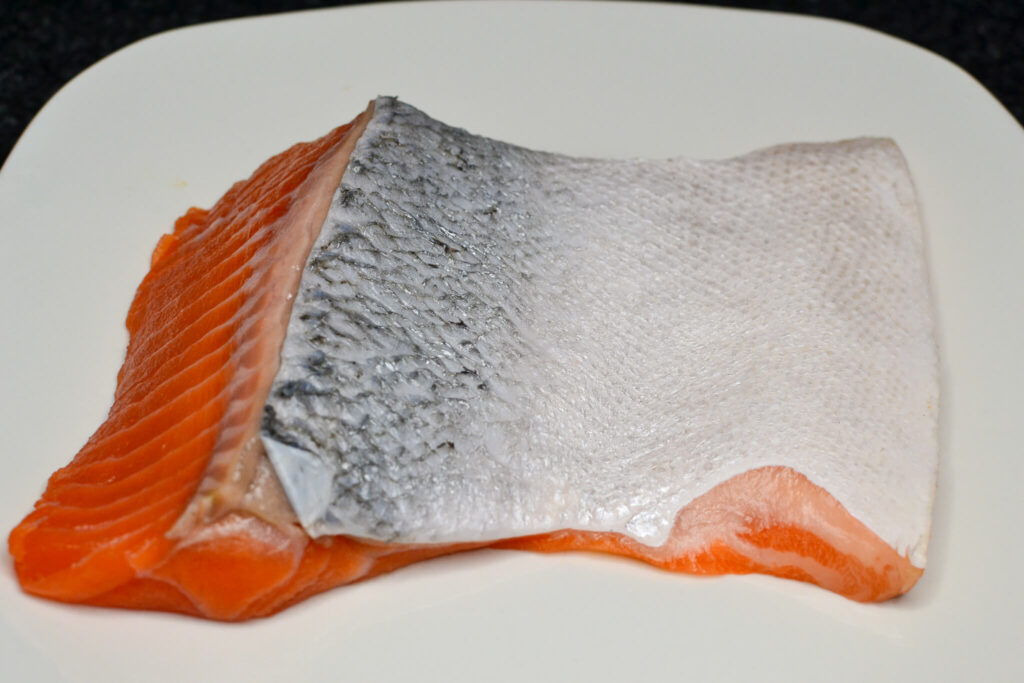
When you have the salmon fillet ready, start by taking off the skin if it’s still on. This requires a careful and steady slice between the skin and the flesh, with the knife angled slightly down so you don’t lose any of the valuable salmon. After the skin is off, check the fillet for any left-behind pin bones, which you can remove with tweezers.
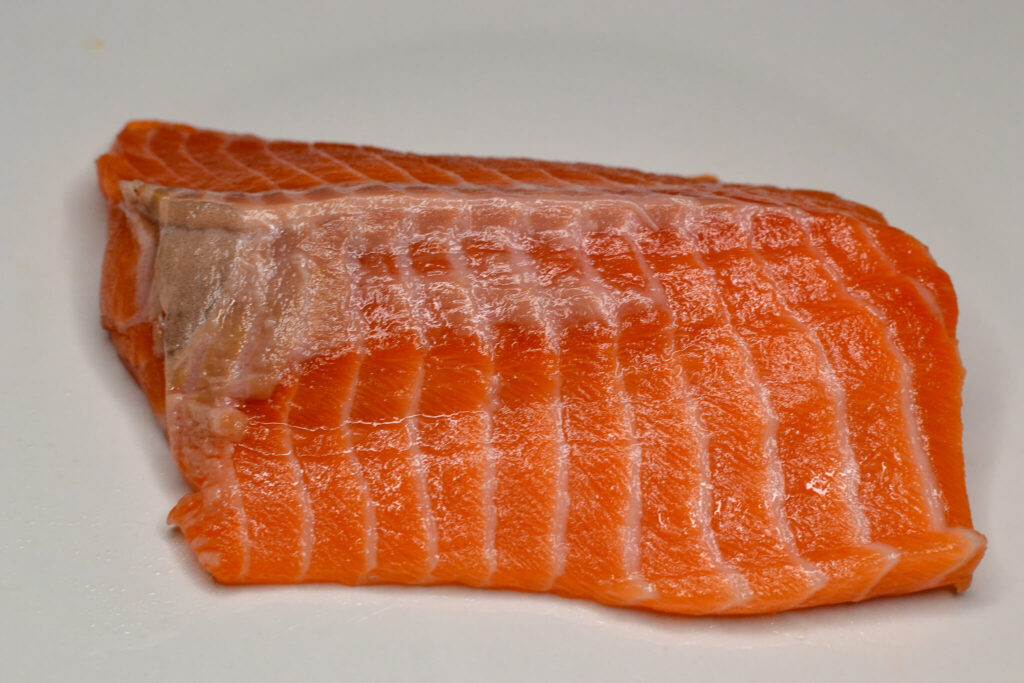
After the skin is off, check the fillet for any left-behind pin bones, which you can remove with tweezers.

Cutting the sushi grade salmon into strips requires precision. The aim is to make strips that are all the same size, so each bite of the roll has an even amount of salmon. To do this, cut the salmon across the muscle fibers. This makes the pieces tender and easy to eat.

The strips should be evenly thick, around a centimeter wide, to make sure they fit nicely in the roll and balance well with the other ingredients without overwhelming them.
Step 4
Roll Sushi

Start by laying a sheet of nori on the plastic-wrapped bamboo mat, shiny side down. The seaweed sheets act as the outer layer of the roll, so its placement is crucial. Dip your hands in the bowl of water to moisten them, then grab a ball of sushi rice.
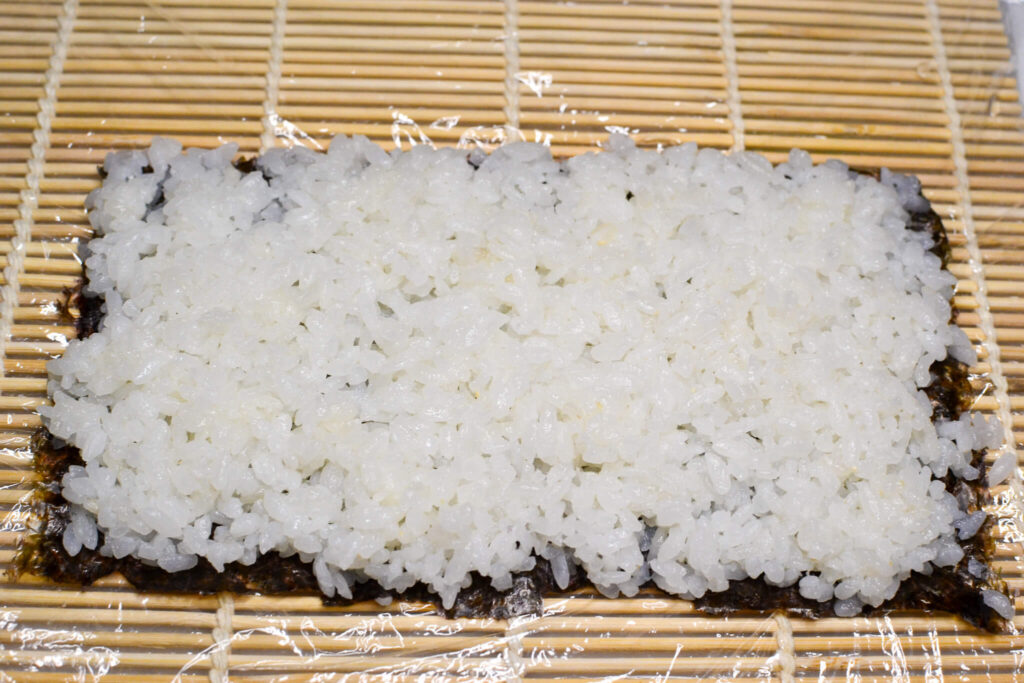
Spread the rice evenly across the nori, leaving about an inch of space at the top edge. This rice-free margin is essential for sealing the roll. The layer of rice should be thin enough to let the nori peek through slightly, ensuring the roll isn’t overly dense.
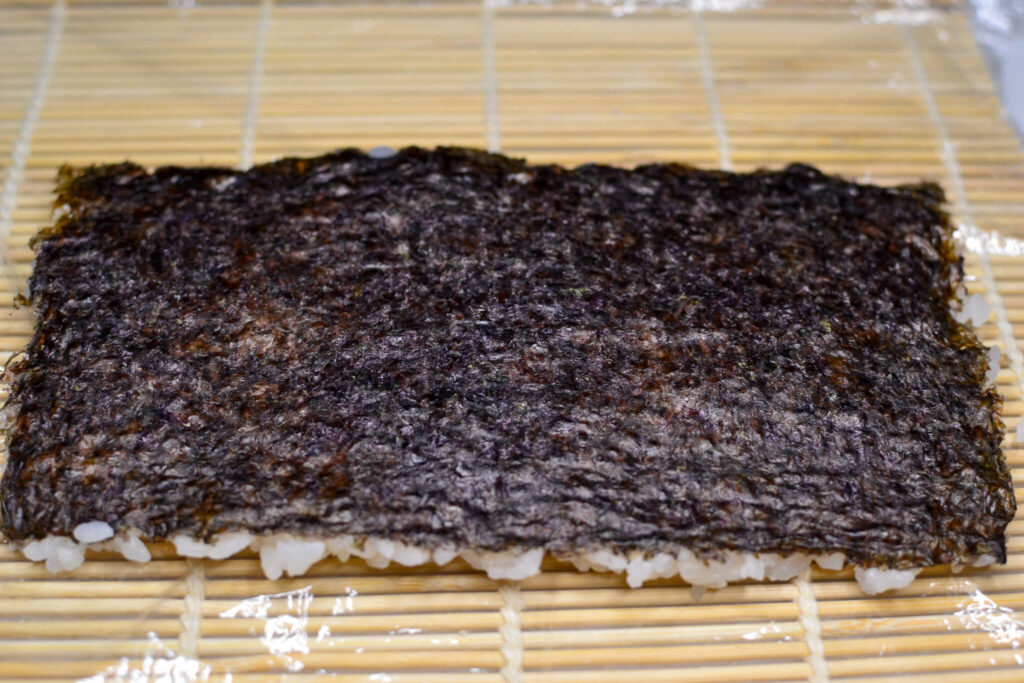
After spreading the sushi rice on the nori, flip the nori over so the rice is on the bottom. This step is key for Alaska Rolls, where the rice is on the outside.

After turning the nori so the rice side is down, start with the avocado. Place the avocado slices close to the nori’s bottom edge, spreading them out evenly. The avocado’s creamy texture enhances the roll, offering a smooth counterpoint to the other ingredients. Arrange these slices to be at the heart of the finished roll, ensuring a balance of flavor and texture with each bite.
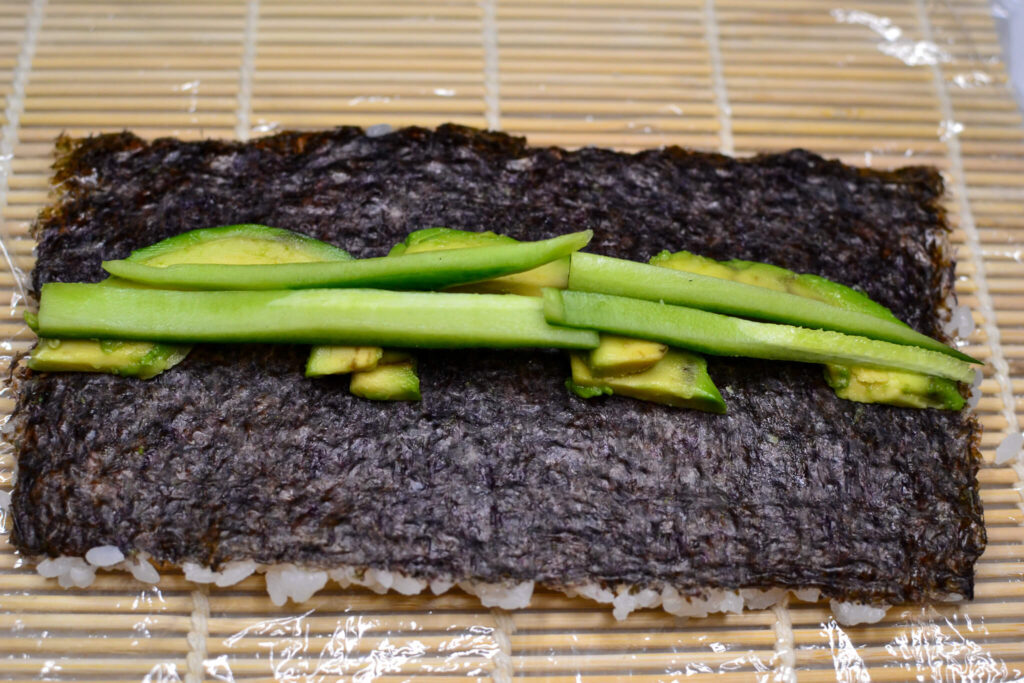
Then, place the cucumber strips next to the avocado. The cucumber’s crispness adds a refreshing crunch, important for the texture contrast in the Alaska Roll. Spread the cucumber strips evenly, lining them up with the avocado to keep the roll’s structure and to make sure the cucumber’s fresh taste is felt in every part of the roll.
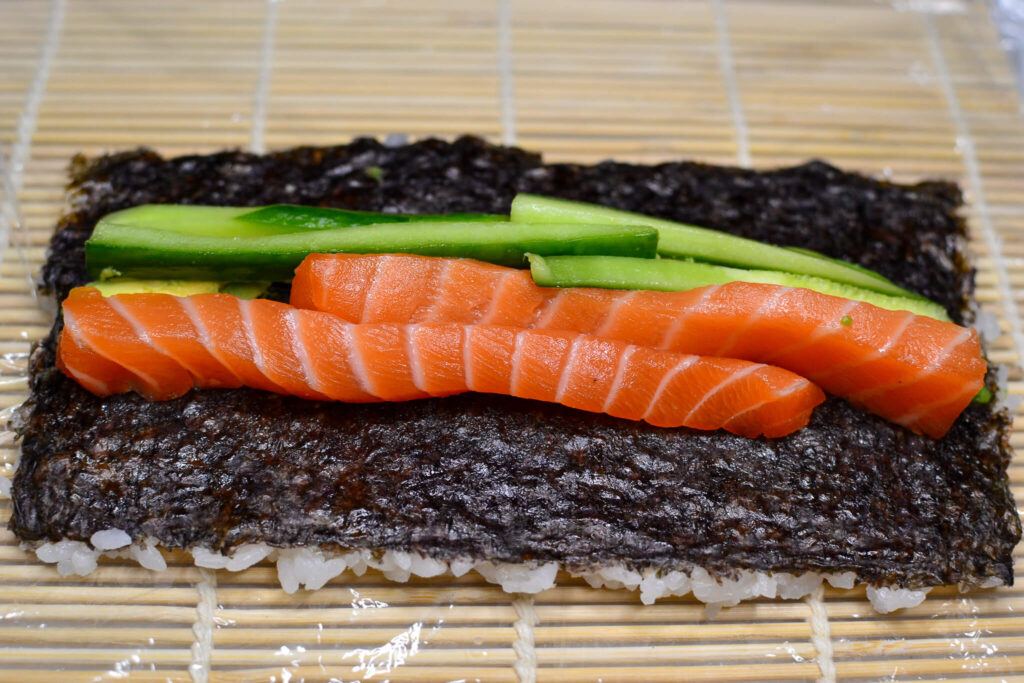
Lastly, put the salmon strips over the avocado and cucumber. The salmon brings a deep, umami taste crucial to the roll’s flavor. Place the salmon neatly, making sure not to pack it too tightly, so the roll can close well. Arranging the salmon thoughtfully is important for a balanced mix of tastes and an attractive look when the roll is cut.

With the fillings set, it’s rolling time. Pick up the bottom edge of the mat (the edge closest to you) and use it to fold the nori over the fillings. Gently yet firmly, pull the nori’s edge under the fillings to start the roll. Keep rolling, using the mat to shape and guide the sushi into a tight roll. It’s important to press evenly with your fingers to make sure the roll is tight and even.
After rolling over the rice, you’ll come to the part of the nori without rice at the top. Wet this edge slightly with water; this will help seal the roll. Finish rolling, pressing gently on the mat to make sure the roll is tight and holds together.

Now that your sushi roll is ready, it’s time to turn it into bite-sized pieces. Use a sharp knife that’s been wetted to cut the roll into eight equal parts. The wet knife keeps rice from sticking, making for cleaner slices. Begin by cutting the roll in half, then split each half into two, and finally, cut each quarter into two pieces. This approach ensures evenly sized slices. Cleaning the knife with a wet cloth between cuts is a good practice to keep the edge sharp and clean.

This method helps achieve uniform slices. Between cuts, it’s helpful to clean the knife with a wet cloth to maintain a sharp, clean edge.
Step 5
Enjoy Your Alaska Roll!
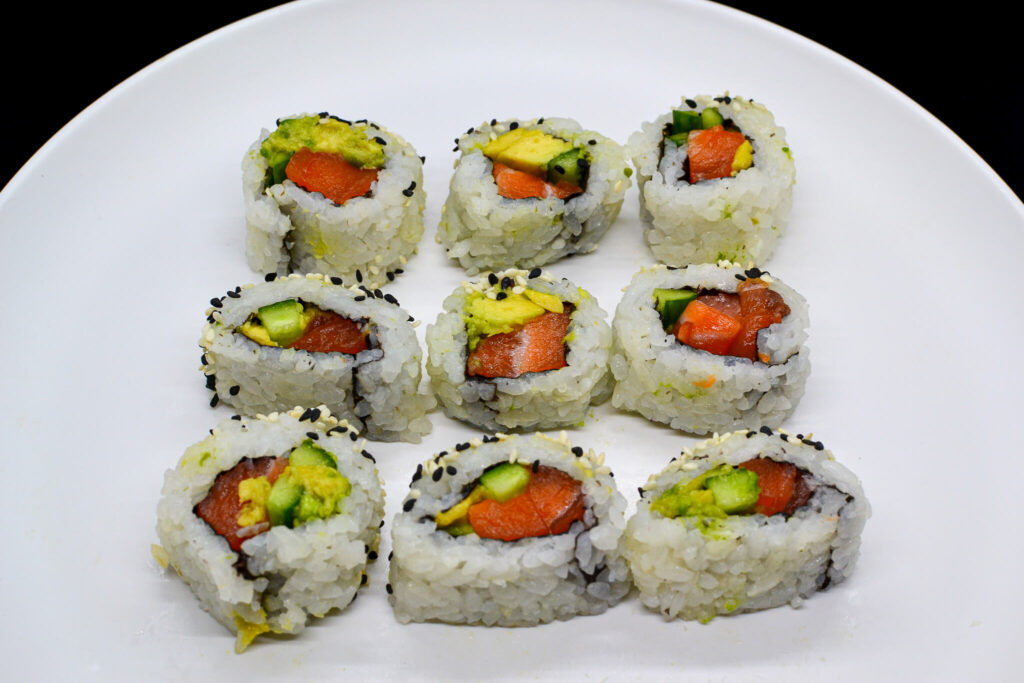
Before cutting the Alaska Roll, I added a touch of black and white sesame seeds to the outside. This not only makes the roll look better by adding color contrast to the rice, but also adds a slight nutty taste and a nice texture difference with each bite.
The sesame seeds stick to the rice’s moist surface, making sure they stay on as you cut and serve the roll. This extra touch improves the presentation and brings another layer of flavor to the tasty mix of cucumber, avocado, and salmon in the roll. This sushi recipe is ideally complemented by a selection of soy sauce, eel sauce, spicy mayo, or pickled ginger. While wasabi isn’t to my taste, it might be the perfect addition for you.
Making sushi is as fulfilling as it is detailed. It’s a chance to combine all your efforts into a dish that’s both delicious and visually stunning. And remember, getting better at it comes with practice.
Enjoy!

Ex Machina

Inspiration
Kyoko’s Sushi

More About Alaska Roll

Alaska Roll
Ingredients
- 2 Mini Cucumbers
- 1 Avocado
- 2 cups Sushi Rice
- 2 tbsp Sugar
- Nori Sheets
- 1 lb Sushi-Grade Raw Salmon
Instructions
Wash & Cook Rice
- Rinse 2 cups of sushi rice under cold water until the water runs clear. Drain well.
- Cook the rice in a rice cooker or on the stovetop using a 1:1.2 ratio of rice to water. After cooking, let the rice sit for 10 minutes to steam.
- Mix 1/2 cup rice vinegar, 2 tbsp sugar, and a pinch of salt. Stir into the warm rice, then let it cool to room temperature.
Prep Produce
- Slice the mini cucumbers into thin strips, removing seeds.
- Cut the avocado in half, remove the pit, and slice the flesh into thin pieces.
Cut Salmon
- Remove the skin from the sushi-grade salmon and check for pin bones.
- Slice the salmon into even strips, about 1 cm thick, ensuring each piece will fit neatly in the roll.
Roll Sushi
- Lay a sheet of nori on a bamboo mat, shiny side down. Wet your hands and spread a thin layer of rice over the nori, leaving a 1-inch border at the top.
- Flip the nori over so the rice is on the bottom. Add avocado, cucumber, and salmon to the center.
- Roll the sushi tightly, using the mat to help guide and shape it. Wet the top edge of the nori to seal the roll.
- Slice into 8 pieces with a sharp, wet knife.
Enjoy Your Alaska Roll
- Garnish with black and white sesame seeds. Serve with soy sauce, spicy mayo, pickled ginger, and wasabi if desired.
The Alaska Roll is a relatively easy sushi to make that fits into the wide, varied world of Western sushi inspired by Japanese cuisine. Unlike the centuries-old traditional Japanese sushi, the Alaska Roll is a newer creation without a clear origin story or creator. It’s part of the worldwide adaptation and change of sushi, designed to meet the tastes and ingredient availability in the West.
The name “Alaska Roll” hints at its use of Alaskan salmon, a key part of this roll and a major product from Alaska. Salmon became a popular sushi ingredient in the late 20th century, especially after Norwegian seafood exporters successfully promoted it in Japan in the 1980s. This happened as sushi was becoming more popular in the West, leading to new sushi variations with ingredients that suited local preferences and resources.
Alaska Roll Sushi usually has raw or smoked salmon, avocado, cucumber, rice, and nori. These ingredients mix traditional sushi with the preference for salmon’s rich and fatty texture common in Western food. It’s often topped with sesame seeds or tobiko (flying fish roe) for extra taste and texture. This is so much better than just using imitation crab.
The creation of the Alaska Roll shows the global spread of sushi, adapting to different local tastes and available ingredients around the world. While it might not have a specific origin or the long history of traditional Japanese sushi, the Alaska Roll showcases the creativity and dynamic nature of global sushi. It’s a symbol of how blending different culinary traditions can make food like sushi more accessible and enjoyable worldwide.
The finest sushi restaurant I’ve had visited was Sushi Den in Denver, Colorado. It was truly exceptional.

